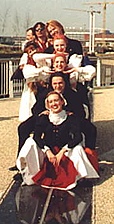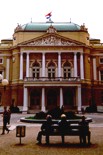On Saturday 8 April, the ballet troupe "Croatia" arrived at the Millennium Dome in Greenwich, London, to give a series of performances of part of the ballet The Gingerbread Heart, with music by the Croatian composer Kresšimir Baranović.
Their performance was wonderful, with dancing as good as you could see anywhere in the world, and with a disciplined excellence and the athletic quality of male lead dancing typical of those trained in the Russian school. The story was made easy to follow by expressive miming and good acting, and the energy and spirit of the dancers was so catching that the performances were received with enthusiastic applause from the English audience.
The Gingerbread Heart is one of
 |
| "Croatia" |
Russian dancers Margaret and Maximilian Froman arrived from Russia in 1920 and had a huge impact on the Croatian company which, due to their influence, reached the high standards of the leading European companies of the time. The Russian influence was still very much in evidence in the performance at the Millennium Dome, with its commitment to group discipline and a classical but athletic style of solo dancing.
While the main ballet company in Zagreb has often worked with contemporary choreographers, the touring company tends to choose the safe and popular options for its repertoire, performing mainly classical works. In the case of the visit to Britain, the choice was an act from a ballet that gave a picture of Croatian village life from the past.
Sweet, but slightly pungent like gingerbread, its ingredients added up to a kind of sticky, sugary romanticism designed to attract the visitor to Croatia. The scene is of a square in old Zagreb. A young boy buys from the gingerbread man a gingerbread heart for his girl. He gives it to her to show his love and devotion, and everybody dances with happiness to celebrate their love. Little problems and conflicts mar their happiness, but stability and security reign in the end, and everyone lives happily ever after.
The dancers wear national costume throughout the ballet, and the atmosphere of the music is sunny, like the photographs of Croatia that were chosen by Flora Turner, the advisor for culture to the Croatian Embassy, and displayed on the walls outside the theatre of the Dome. Like most of the other productions that resulted from an open invitation to theatre companies to participate in the Dome's "Theatre of the World" project, the performance promoted a nation through an old idea of itself, the idea of a (now almost extinct) communal village life with stability and tradition. It is interesting that, out of the 30 participating countries, only two offered modern performances. The rest represented their countries with a picture of the past and, in many cases, with national dress.
 |
| The director |
It is interesting to note that, according to the ballet troupe's administrator, Andreja Kovacic, the main goal of the company is "to promote the art of ballet in Croatia and abroad." It is a "mobile" and "cost-effective" company that takes ballet to places that often cannot afford to put on a large, expensive performance.
 |
| National Theatre, Zagreb |
The modern world is, however, a more
 |
| London's Millennium Dome |
There is so much irony, though, in that this small but excellent ballet troupe travelled to London to represent a re-emerging nation with a ballet that, albeit performed in Croatian national costume, had music composed by a musician that spent much of his professional life in Belgrade and Vienna and travelled the world with the ballet company of Anna Pavlova (who was Russian but lived in London). There is also irony in that the ballet was re-choreographed and produced by a dancer who trained in St Petersburg and danced by a company that inevitably has dancers from countries other than Croatia.
What these ironies demonstrate is that the arts, and particularly the non-verbal arts, are international in today's world, and the cross-fertilisation of style in the world of art is such that it is difficult for any one country to stake an absolute claim on a particular artist or art work. Rather, a good artist is like a feather on the cap of a country, and so is an art work or, for that matter, a first performance of an art work. It is interesting, for example, to observe that, while one dictionary lists The Gingerbread Heart as having had its first performance in Belgrade in 1950, another source of information claims that the first performance took place in Zagreb and yet another (British) source suggests that the work was first performed at the Edinburgh festival in Scotland.
Whatever the truth is, the manner of the recording of such "facts" about art demonstrates the reality that, despite the essential internationalism of art, artists and their works of art are like brightly coloured feathers that are stuck in the national cap and worn with pride, irrespective of their mixed origin.
Sue Bagust, 15 May 2000
Moving on:



